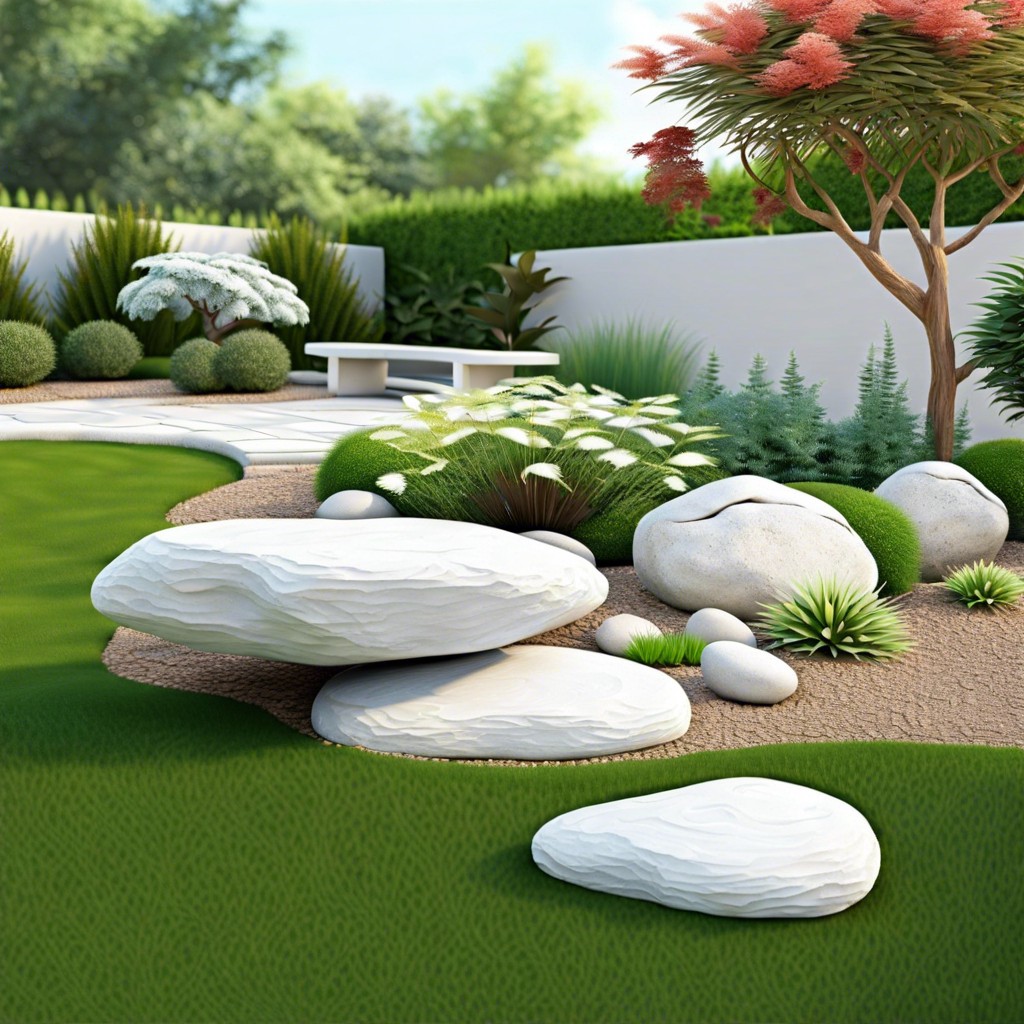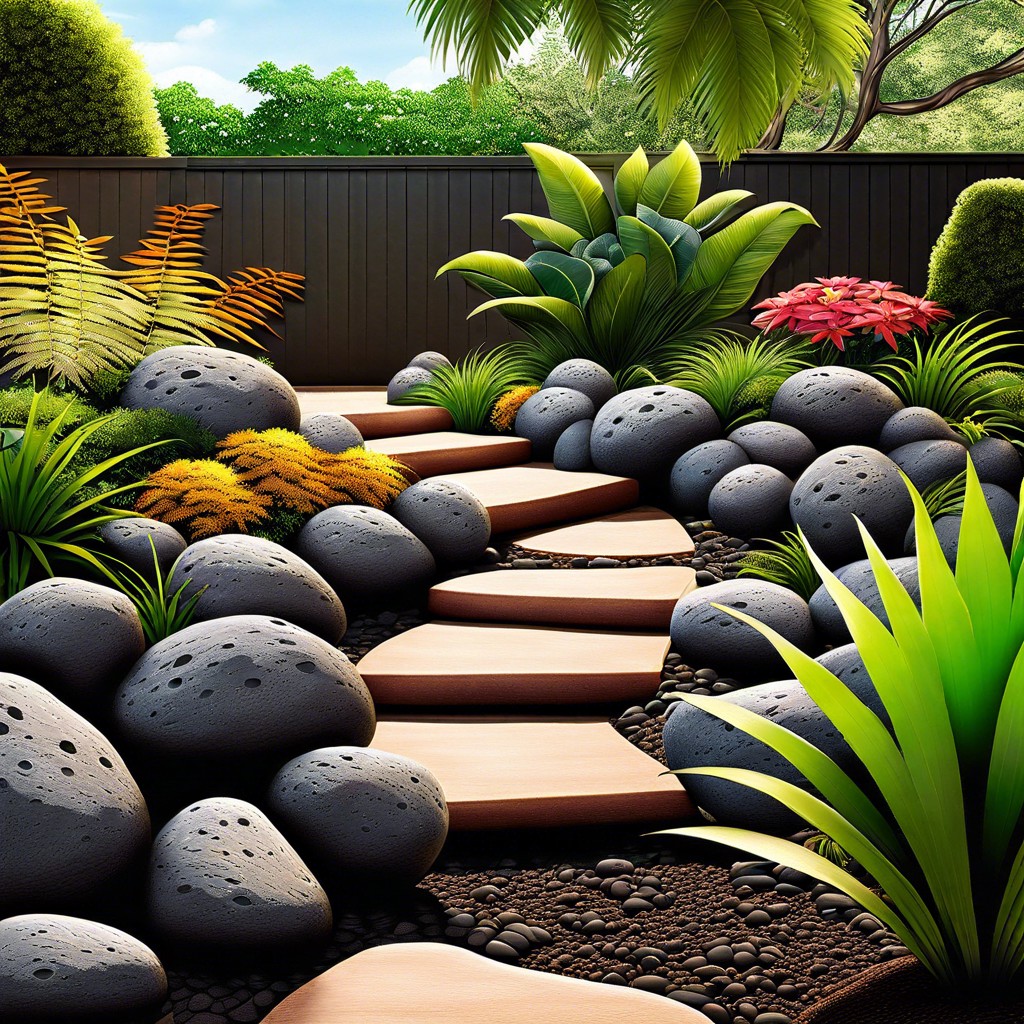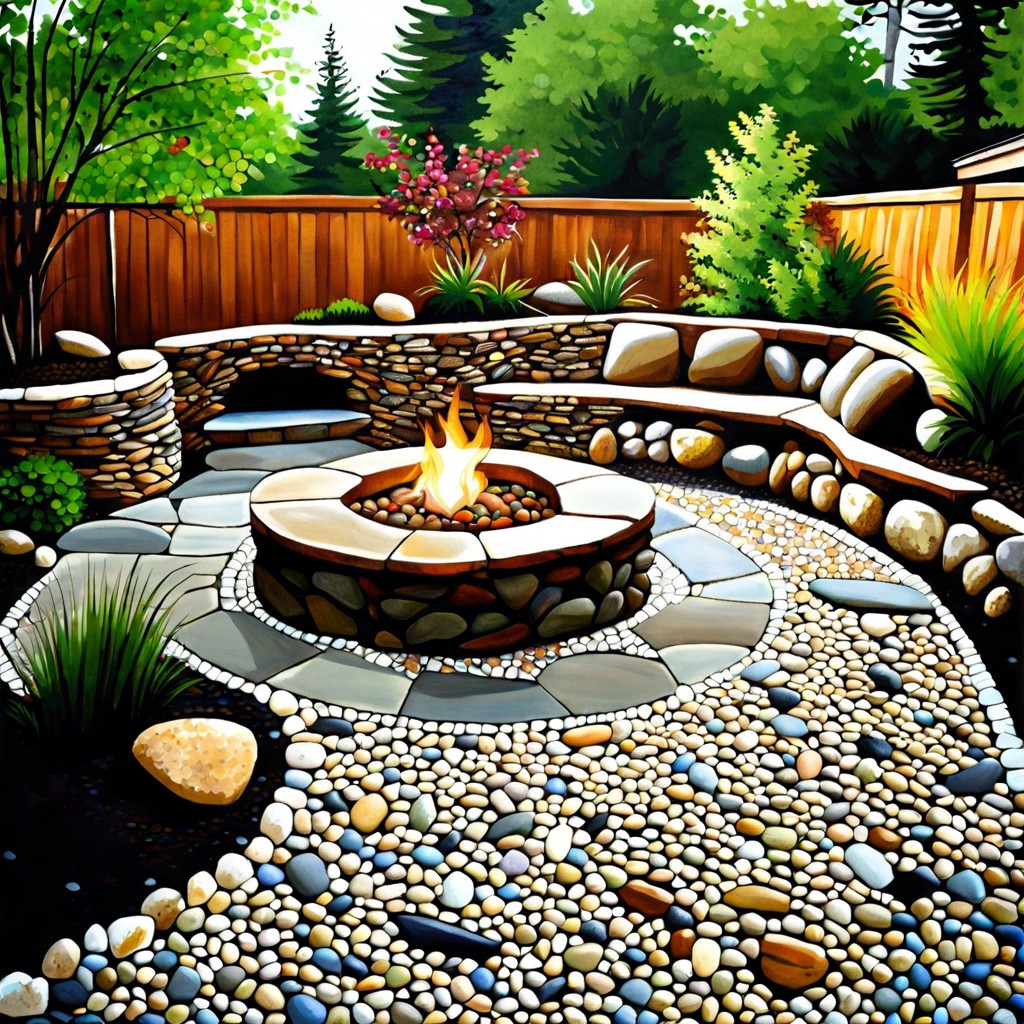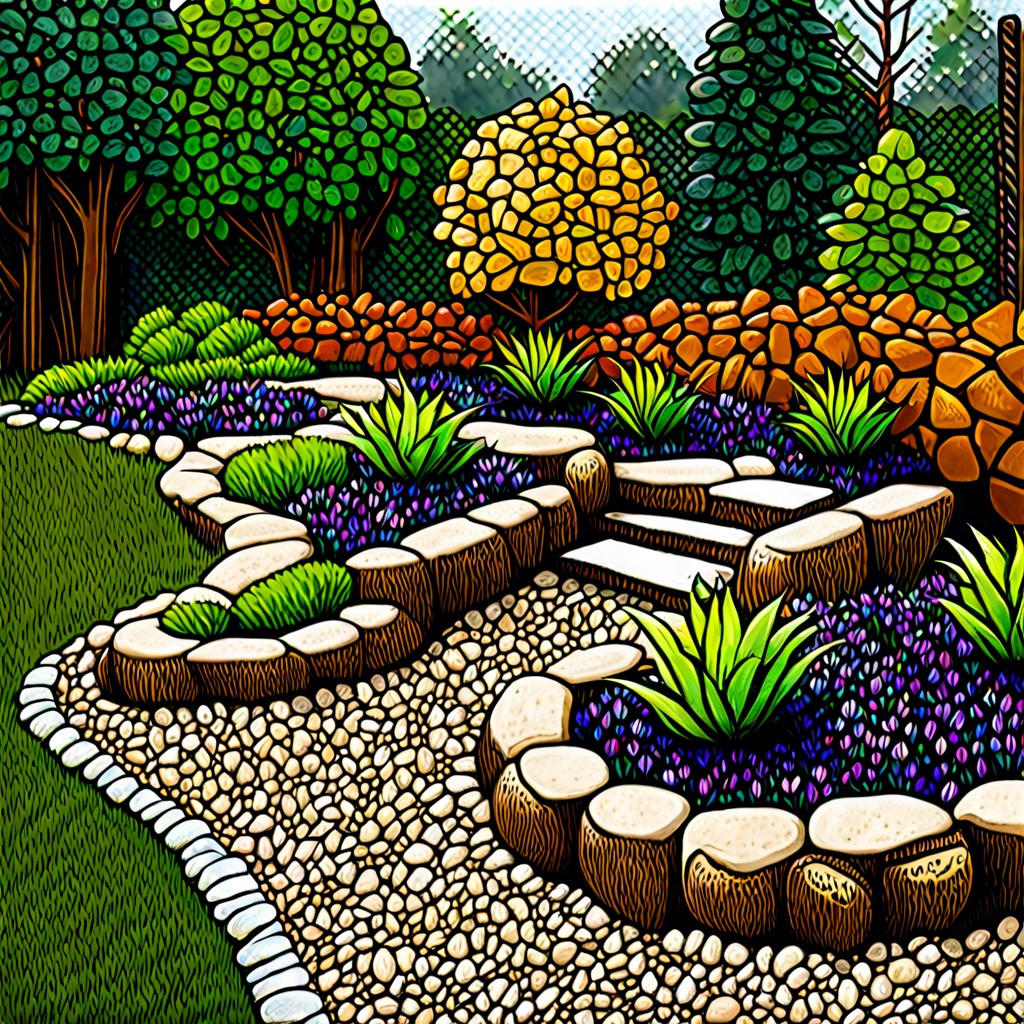Discover the essential considerations for selecting the perfect white landscaping rock to enhance your outdoor space in this comprehensive buying guide.
Key takeaways:
- White landscaping rocks have visual appeal and practical benefits.
- Types of white landscaping rocks include marble chips, white river rock, white limestone, and pea gravel.
- Consider factors like size, texture, functionality, color consistency, climate, and cost when choosing white rocks for your landscape.
- Important installation tips include measuring the space, preparing the area, considering depth, proper edging, raking for an even look, and regular maintenance.
- White rocks can impact the local ecosystem, so consider heat sensitivity, water flow, sourcing locally, and the habitat needs of local wildlife.
Benefits of Using White Landscaping Rock

White landscaping rock has a clean, bright look that can greatly enhance the aesthetic appeal of any garden or outdoor space. These rocks reflect sunlight, brightening the garden’s appearance and creating a mesmerizing contrast with the green of plants or the blue of a pool.
In addition to their visual appeal, using white rocks in landscaping has practical benefits. They serve as a natural weed barrier, reducing the time and effort required for garden maintenance. When spread out over a weed-control fabric, they effectively suppress unwanted growth, allowing plants you want to highlight to take center stage.
The durability of white rocks is another significant advantage. They are an excellent option for a long-lasting ground cover since they do not degrade over time like mulch does. This means less frequent replacement, thus offering a cost-effective solution in the long run.
Moreover, these rocks aid in soil temperature regulation. They reflect heat away from the soil which helps to keep plant roots cooler during hot summer months. Additionally, during rain or watering, the rocks can help minimize soil erosion by protecting against the impact of water droplets.
Lastly, white landscaping rock is versatile and can be used in various design styles, from modern minimalist gardens to rustic country yards. Whether you’re aiming to create a serene Zen garden or a chic, contemporary outdoor living area, white rocks can provide the perfect finishing touch.
Types of White Landscaping Rocks
When selecting white rocks for your garden, you’ll find a variety of materials, each with unique characteristics. Marble chips are a popular choice, known for their shimmering surface that can brighten any garden path or bed. Their cool, sophisticated appearance works exceptionally well in formal landscapes.
For a more rugged look, white river rock could be your go-to. These naturally rounded stones come in various sizes and are perfect for creating dry riverbeds or accentuating water features. Plus, their smooth texture makes them a safe option for areas with barefoot traffic.
If you prefer a rustic aesthetic, white limestone is a practical option. Its rough texture not only adds visual interest but also provides excellent ground coverage, helping to suppress weeds. Limestone, however, may affect soil pH, so it’s wise to consider the needs of your plants before committing.
Finally, pea gravel is a versatile, pea-sized stone that’s great for walkways and patios. It compacts well, providing a stable surface for foot traffic while still ensuring proper drainage.
By understanding the strengths and uses of each white rock type, you can make an informed decision that enhances your landscape while meeting your practical needs.
Choosing the Right White Rock for Your Landscape
Selecting the perfect white rock for your landscape hinges on several factors that will harmonize with your gardening needs and aesthetic aspirations. Consider the following points to guide your decision:
Size Matters: The scale of the rocks in relation to your space is key. Smaller pebbles can create elegant paths, while larger stones make for eye-catching features. Think about the area you wish to cover and choose a size that complements, rather than overwhelms or disappears into the landscape.
Texture Variety: Rocks can range from smooth and polished to rough and jagged. Smooth stones often contribute a more refined appearance, whereas rougher textures offer a rugged, natural feel. Your choice should align with the mood you want to set in your garden.
Functionality: Besides beauty, contemplate the role the rocks will play. If you’re looking to suppress weeds or facilitate drainage, certain types of white rocks may be more suitable. For example, crushed rock is excellent for coverage and weed control, whereas larger stones can help with water flow and retention.
Color Consistency: Not all white rocks are a pure white; some have veins or hints of other colors. Consider whether you want a stark white to brighten up your landscape or a softer tone that blends more naturally with your environment.
Local Climate: The weather patterns of your region can influence the longevity and maintenance of your white rocks. In wet climates, porous rocks can harbor moisture and promote moss, while in hot climates, a reflective surface could be harsh on surrounding plants.
Availability and Cost: Lastly, explore what’s readily available in your area and fits within your budget. Transporting rocks can be expensive, so choosing a locally sourced material can save costs and support the local economy.
Taking these points into account will help you find the right white rock that is practical, aesthetically pleasing, and maintains its appeal through the changing seasons of your garden.
Installation Tips for White Landscaping Rock
When embarking on the installation of white landscaping rocks, there are several practical tips to ensure a beautiful and enduring result:
- Measure Your Space: ** Before purchasing your white rocks, measure the area where you intend to place them. You’ll want to know the square footage to buy the right amount of rock.
- Prepare the Area: ** Clear the space of any weeds, debris, and other materials. You may want to lay down a layer of landscape fabric to prevent weed growth and to keep the rocks from sinking into the soil over time.
- Consider Depth: ** For adequate coverage that suppresses weeds and provides a full look, aim for a depth of about two inches of rock. Keep in mind that areas with heavier foot traffic may need more depth to prevent the rocks from dispersing.
- Proper Edging: ** Installing a firm border or edging will help to keep the rocks contained and maintain the clean lines of your design. Choose a material that complements both your house and the white rock.
- Raking for an Even Look: ** Once you’ve spread the rocks, use a rake to even out the surface. This helps distribute the rocks uniformly and achieve that pristine, maintained appearance.
- Maintenance: ** While white rocks are relatively low maintenance, they can gather leaves, twigs, and other debris. A periodic wash or gentle rake will keep them looking bright and clean.
- Protect against Discoloration: ** White rocks can sometimes lose their luster or become discolored due to weather or irrigation. Consider using rainwater for irrigation if possible, and refresh the top layer of your rocks every few years to maintain that crisp white look.
By following these straightforward steps, your white landscaping rock will serve its intended purpose effectively, enhancing the curb appeal and aesthetic beauty of your outdoor space.
White Rock and Local Ecosystem Considerations
Incorporating white landscaping rock can be aesthetically pleasing, but it’s crucial to consider the impact on your local ecosystem. These light-colored stones can reflect more sunlight, which could potentially alter the temperature of your garden. Plants sensitive to heat might not thrive when surrounded by white rocks.
Another consideration is the permeability of the rock. Solid white rock formations might restrict water flow and could affect the moisture levels in your soil. If your garden typically benefits from ample rainwater, non-porous rocks could lead to run-off issues, possibly depriving plants of necessary hydration.
It’s also important to think about the origin of the stones. Ideally, opt for locally sourced materials which are more eco-friendly and often better suited to the native flora and fauna. Long-distance transportation of rock can result in a larger carbon footprint, which contradicts eco-conscious landscaping efforts.
Lastly, aim to understand the habitat needs of local wildlife. White rocks can be attractive but may not provide the best shelter or environment for beneficial insects, birds, or small mammals that contribute to a healthy garden ecosystem. Make sure the use of white landscaping rock balances both beauty and responsibility towards your local environment.




